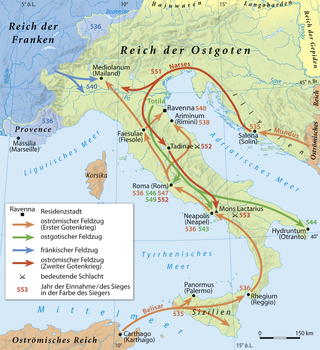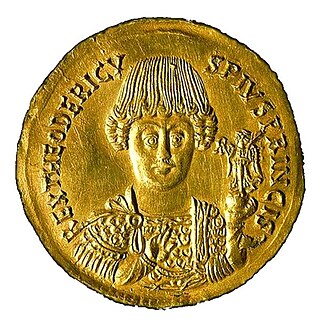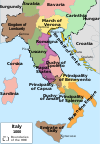Related Research Articles

The Ostrogoths were a Roman-era Germanic people. In the 5th century, they followed the Visigoths in creating one of the two great Gothic kingdoms within the Roman Empire, based upon the large Gothic populations who had settled in the Balkans in the 4th century, having crossed the Lower Danube. While the Visigoths had formed under the leadership of Alaric I, the new Ostrogothic political entity which came to rule Italy was formed in the Balkans under the influence of the Amal dynasty, the family of Theodoric the Great.
The 540s decade ran from January 1, 540, to December 31, 549.

Year 541 (DXLI) was a common year starting on Tuesday of the Julian calendar. In the Roman Empire, it was known as the Year of the Consulship of Basilius without colleague. Basilius was the last person to be officially appointed Roman consul, since after this year, the office was permanently merged with the office of Roman/Byzantine emperor. Thus, from the next year forward, the consular year dating was abandoned. The denomination 541 for this year has been used since the early medieval period, when the Anno Domini calendar era became the prevalent method in Europe for naming years.

Year 544 (DXLIV) was a leap year starting on Friday of the Julian calendar. The denomination 544 for this year has been used since the early medieval period, when the Anno Domini calendar era became the prevalent method in Europe for naming years.

Marcian was Roman emperor of the East from 450 to 457. Very little of his life before becoming emperor is known, other than that he was a domesticus who served under the commanders Ardabur and his son Aspar for fifteen years. After the death of Emperor Theodosius II on 28 July 450, Marcian was made a candidate for the throne by Aspar, who held much influence because of his military power. After a month of negotiations Pulcheria, Theodosius' sister, agreed to marry Marcian. Zeno, a military leader whose influence was similar to Aspar's, may have been involved in these negotiations, as he was given the high-ranking court title of patrician upon Marcian's accession. Marcian was elected and inaugurated on 25 August 450.

Totila, original name Baduila, was the penultimate King of the Ostrogoths, reigning from 541 to 552 AD. A skilled military and political leader, Totila reversed the tide of the Gothic War, recovering by 543 almost all the territories in Italy that the Eastern Roman Empire had captured from his Kingdom in 540.
Ildibad was a king of the Ostrogoths in Italy in 540–541 CE.

The Battle of Mons Lactarius took place in 552 or 553 AD during the Gothic War waged on behalf of Justinian I against the Ostrogoths in Italy.
Germanus was an Eastern Roman general, one of the leading commanders of Emperor Justinian I. Germanus was Emperor Justinian's cousin, and a member of the ruling dynasty. He held commands in Thrace, North Africa, and the East against Persia, and was slated to command the final Byzantine expedition against the Ostrogoths. Having married into the Gothic Amal royal line through his second wife Matasuntha and a distinguished service record, at the time of his sudden death, he was considered the probable heir to Emperor Justinian.

The Gothic War between the Eastern Roman Empire during the reign of Emperor Justinian I and the Ostrogothic Kingdom of Italy took place from 535 to 554 in the Italian Peninsula, Dalmatia, Sardinia, Sicily and Corsica. It was one of the last of the many Gothic Wars against the Roman Empire. The war had its roots in the ambition of the Eastern Roman (Byzantine) Emperor Justinian I to recover the provinces of the former Western Roman Empire, which the Romans had lost to invading barbarian tribes in the previous century, during the Migration Period.

The Ostrogothic Kingdom, officially the Kingdom of Italy, existed under the control of the Germanic Ostrogoths in Italy and neighbouring areas from 493 to 553.

The Battle of Sena Gallica, was a naval battle fought off the Italian Adriatic coast in the autumn of 551 between an East Roman (Byzantine) and an Ostrogoth fleet, during the Gothic War (535–554). It marked the end of the Goths' brief bid to deny the seas to the Romans, and the beginning of the Byzantine resurgence in the war under the leadership of Narses.
Aligern or Aligernus was an Ostrogoth military leader, active in the Gothic War (535-554). By the end of the war, Aligern had joined the Byzantine army. The main sources about him are Procopius and Agathias.

The city of Rome was besieged in AD 549–550 by the Ostrogoths, led by Totila, during a campaign to recapture Italy from the Byzantine Empire. After Totila imposed a blockade, soldiers from the city's garrison opened the gates to him. Many of the male inhabitants were killed in the city or while attempting to flee. The city was afterwards repopulated and rebuilt.
The Battle of Mucellium was an engagement in 542 near Mugello, Italy, between Ostrogoths and Byzantines during the Gothic War. Having lifted a siege of Florence, the Ostrogoths led by Totila turned on the pursuing Byzantines, defeating their numerically superior force.
The siege of Naples was a successful siege of Naples by the Ostrogothic leader Totila in 542–543 AD. After crushing the Byzantine armies at Faventia and Mucellium, Totila marched south towards Naples, held by the general Conon with 1,000 men. A large-scale relief effort by the newly appointed magister militum Demetrius from Sicily was intercepted and almost entirely destroyed by Gothic warships. A second effort, again under Demetrius, likewise failed when strong winds forced the fleet's vessels to beach, where they were attacked and overrun by the Gothic army. Knowing the dire situation of the city's defenders, Totila promised the garrison safe passage if they surrendered. Pressed by famine and demoralized by the failure of the relief efforts, Conon accepted, and in late March or early April 543, Naples surrendered. The defenders were well treated by Totila, and the Byzantine garrison was allowed safe departure, but the city walls were partly razed.
John, the nephew of the rebel Vitalian, was an Eastern Roman general under Justinian I, who was active in the Gothic War in Italy and against the Gepids in the western Balkans. He was married to Justina, the daughter of Justinian's cousin Germanus.
Indulf, also known as Gundulf, was a Byzantine mercenary who defected to the Ostrogoths and became a leader in their army in the last years of the Gothic War of 535–554.
Coccas was an Eastern Roman soldier who deserted to the Ostrogoths during the final stages of the Gothic War. Procopius calls him "a Roman soldier" and "a man of the Gothic army". His name is not Germanic, and might be Thracian.
Chalazar was a Hun military commander in the Byzantine Empire.
References
- ↑ History of the Later Roman Empire: From the Death of Theodosius I to the Death of Justinian, by J. B. Bury. Charles River Editors, 2018.
- ↑ The Age of Justinian: The Circumstances of Imperial Power, p. 151, by J. A. S. Evans. Routledge, 2002.
